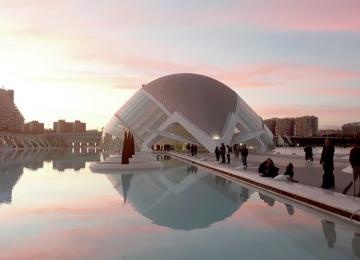Architectural routes in Valencia
Discover the city's most unique buildings
A walk through Valencia is a journey through 2,000 years of history, as reflected in the various architectural styles that can be found throughout the city. You don't have to be an expert to appreciate the beauty of the Silk Exchange or be enthralled by the silhouettes of the City of Arts and Sciences. These are architectural jewels that catch the eye, but there are many more in Valencia to discover.
Once a year, the Open House Valencia architecture and urban design festival offers a chance to explore some of the unique buildings that are not normally open to the public through its open house days. The Open House also offers four architectural routes through the city that you can easily follow on your own at any time to enjoy the most fascinating buildings in the city. Want to try them out?
The 10 essentials
If you only have time for one architectural route, there are some buildings that you just can't miss out on. The Roman site of l'Almoina, the wonderful Gothic civil architecture of the Silk Exchange (designated a World Heritage Site), and the colorful modernist Central Market are some of these must-sees. Also on the route are the most spectacular examples of modern architecture, like the Veles e Vents building in the Marina, and the City of Arts and Sciences, a masterpiece by Santiago Calatrava.
But the Top 10 recommended by Open House also includes some surprises. You can, for example, walk through the tallest gate in Valencia to enter the Teatro El Musical in Cabañal. What if we told you that there is a curious façade reminiscent of an Egyptian temple in the middle of simple housing blocks behind the bullring? It’s the Casa Judía (Jewish House), a jewel of Valencian Art Deco. You can also see the Espai Verd, an original concept in ecological architecture, but only from the outside (to go inside, you will have to wait for the next open house).
I want to know more about this route
Innovation in the Marina
The inner dock of the port of Valencia, refurbished on the occasion of the America's Cup in 2007, has become a leisure and cultural space where you can enjoy walks by the sea or some seafood tapas in the sun. Watching yachts and small boats come and go is as fascinating as taking a tour of the eclectic architecture that borders the Marina.
Early 20th century buildings, such as the old port warehouses with their decorative tiles, the docks where the cargo was stored, the customs building or the iconic clock building that welcomed sailors to Valencia, coexist today alongside the most modern constructions. These include the base of the Swiss sailing team Alinghi, which is today home to cultural exhibits and events, and the Veles e Vents building with its dazzling white cantilevers, the veritable jewel in the crown.
Designed by architects David Chipperfield and Fermín Vázquez, Veles e Vents is the Marina's new landmark, presiding over the entrance to the city by sea. Its interior houses spaces for events and several bars and restaurants where you can rest up at the end of the tour. If you can, book a table at La Sucursal on the top floor, and enjoy not only its excellent cuisine, which boasts two Soles Repsol, but also the best panoramic views of the coastline.
Brutalism and Modernity
The city also features samples of one of the most shocking currents of the modern movement: brutalism. It is a more “raw” architectural style, with sharp, geometric shapes where reinforced concrete and exposed structural elements abound.
Several examples are found in the university area, around Avenida Blasco Ibáñez, including the Faculties of Psychology, Geography and History, and Philosophy and Education Sciences.
The route includes other educational centers such as the Colegio Alemán, instantly recognizable by the combination of mosaics and windows on its façade, and the Colegio Guadalaviar, a unique school from the 1950s. Vegetation and concrete also combine in the ecological homes of Espai Verd, an innovative urban project from the late 20th century. Remember that it can only be seen from the outside, except for visits during the Open House festival.
Goerlich Route
Valencian architect Javier Goerlich Lleó transformed the look of the city in the first half of the 20th century by expanding squares and urban accesses, and adding iconic buildings where modernism, eclecticism and neo-baroque are combined with exotic elements and Art Deco. To him we owe the harmonious design of public spaces such as Plaza de la Reina and Plaza del Ayuntamiento, and some of the monumental buildings that border them, such as the Banco Vitalicio de España-Generali and the Grass-Bianqui Building.
Another of his main legacies is the Avenida del Oeste, the artery that connects the Central Market with the Church of San Agustín, also rebuilt by Goerlich. Along this great thoroughfare that emulates the elegant avenues of other European cities there are slender constructions that combine rationalism with Art Deco elements, such as the Nebot, Martí-Cortina, Torner and Monistrol buildings, among the tallest of their time. Take in its beautiful architecture, but be sure to look down from time to time so you don’t stumble!








